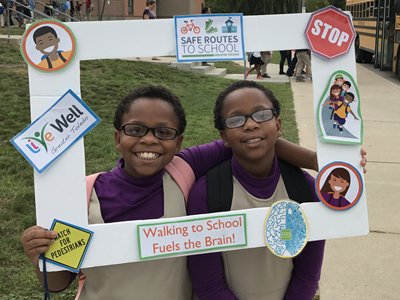Safe Routes to School
Getting kids to school actively safe and sound
 If you’re like us, you have fond memories of walking or riding your bike to school with your siblings or kids on your block, talking, goofing around and burning off some energy along the way. (Okay, maybe trekking a mile on those bitter cold winter days wasn’t quite as much fun as our nostalgic grown-up minds makes it out to be…)
If you’re like us, you have fond memories of walking or riding your bike to school with your siblings or kids on your block, talking, goofing around and burning off some energy along the way. (Okay, maybe trekking a mile on those bitter cold winter days wasn’t quite as much fun as our nostalgic grown-up minds makes it out to be…)
The point is, 50 years ago, almost 50% of students walked or biked to school, and by 2009, that number had dropped to a mere 13%. Concern for safety is a major reason kids don’t walk to school, but small changes—and education—can make a big difference. Here are some things you can do to get more students walking or biking to school:
- Organize your school’s participation in National Walk or Bike to School Day. Walk to School Day is held in October and Bike to School Day is held in May.
- Start a Walk or Bike to School program. Find fact sheets, PowerPoints, program guides and promotional tools through the Center for Disease Control’s KidsWalk initiative.
- Organize a walking school bus, a group of students walking to school at least once a week, supervised by one or more adults. It can be as simple as a few parents taking turns walking their children to school or having a retiree serve as the “bus driver” each morning for a group of kids. Providing adult supervision eases the concerns of parents who live within walking distance to school.
- Start a remote drop-off program by designating one or more sites within walking distance of school (typically ¼ to ½ mile) where parents and school buses drop off students, and students walk the rest of the way with chaperones.
Make sure students know how to safely cross the street.
Yes, most kids are taught, “Stop and look both ways!” at an early age, but it’s a lesson worth repeating.
- Host a school assembly or spend time in PE to review the rules on how to safely cross the street. Review crosswalk signs and traffic signals, reinforce crossing only at marked intersections, and talk about the importance of staying alert when walking or biking.
- Have teachers practice crosswalk safety together at nearby crosswalks with younger children.
- Play Red Light, Green Light! during recess and PE, or host physical activity stations related to crosswalk safety.
- Recruit older students to serve as safety patrol at crosswalks near the school. Educate them on how to monitor and help other students cross the street safely.
- Communicate with community leaders about stationing police, crossing guards or parent volunteers around the perimeter of the school before and after school to help children safely cross the street, especially multi-lane streets.
Help create safe routes to the school!
- Encourage children to walk in groups, and organize responsible adults to accompany them.
- Empower neighborhoods and local agencies to work together to identify and create safe routes to school.
- Partner with police to enforce speed limits in the neighborhood.
- Work with school administrators and community leaders to review crosswalks near the school to make sure routes are clearly marked with proper signs and signals.
Check out Safe Routes to School (SRTS) for more ideas. Run by the Federal Department of Transportation, SRTS has resources, activities and funding to make walking and biking to school safe and routine in your community.
Don’t live close to school? Walk and Bike to School Days can work in any district…even when kids have a 45-minute bus ride to school. Watch how they do it in rural Colorado!
Categories: School Environment